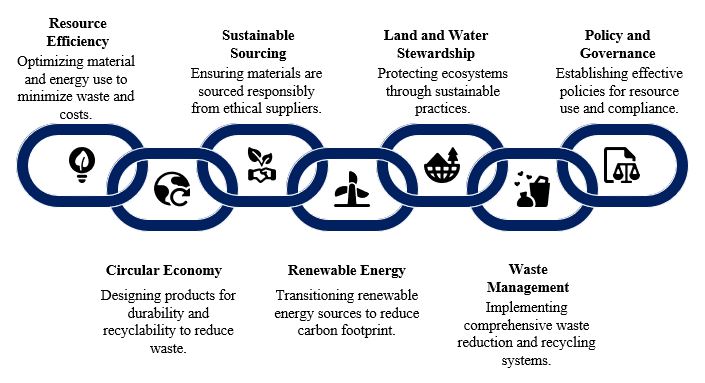Sustainable Resource Management focuses on optimizing the use of natural and man-made resources to ensure long-term environmental, social, and economic balance. Our service helps organizations implement responsible practices in energy, water, materials, and waste management to reduce environmental impact while supporting sustainable growth and regulatory compliance.
Search
Close this search box
Sustainable Resource Management

Sustainable resource management is a core component of the Environmental, Social, and Governance (ESG) framework, driving how companies and investors approach responsible business operations. Integrating sustainable practices ensures that the use of natural resources such as energy, water, raw materials, and land meets present needs without compromising the well-being of future generations.
The Role of Sustainable Resource Management in ESG
Sustainable resource management within ESG centers on resource efficiency, conservation, and responsible sourcing. For investors and regulators, how an organization manages its resource consumption and environmental footprint is a key indicator of long-term viability, resilience, and ethical governance.
Environmental Pillar: Focuses on minimizing environmental impact through reduced waste, energy and water conservation, and transitioning to renewables.
- Social Pillar: Promotes social equity by ensuring fair access to resources, supporting communities, and upholding fair labor practices.
- Governance Pillar: Demonstrates transparent, accountable decision-making about resource use, complying with regulations and reporting standards.
Key Strategies for Sustainable Resource Management

- Resource Efficiency
- Companies strive to use less material and energy per unit of output by redesigning processes and products. Efficient resource use reduces operational costs and environmental impacts.
- Circular Economy Principles
- Adopting circular models means products are designed for durability, repairability, and recyclability, with materials kept in use through reuse, recycling, and remanufacturing minimizing waste and resource depletion.
- Sustainable Sourcing
- Organizations source materials from suppliers that adhere to environmental and social standards, including the use of certified renewable resources and responsible mining or forestry practices.
- Renewable Energy Transition
- Shifting from fossil fuels to renewable sources (solar, wind, hydro) not only reduces the carbon footprint but also helps secure energy for future operations.
- Land and Water Stewardship
- Protecting ecosystems through sustainable agriculture, efficient irrigation, reforestation, and biodiversity conservation ensures the availability and resilience of natural assets.
- Integrated Waste Management
- Companies adopt comprehensive systems for reducing, recycling, and safely disposing of waste including hazardous waste while investing in innovative waste-to-energy technologies.
- Policy and Governance
- Effective policies and transparent reporting on resource use are critical for monitoring, setting targets, and ensuring compliance with global standards and regulations.
Impacts and Benefits
- Operational Efficiency and Cost Savings: Efficient resource management leads to lower operating costs and reduced waste disposal fees, while also potentially opening new revenue streams from recycled or upcycled products.
- Risk Mitigation: Anticipating risks like resource scarcity, regulatory penalties, and reputational harm strengthens business resilience.
- Enhanced Reputation and Access to Capital: Companies demonstrating strong sustainable resource management attract investors and customers seeking responsible, future-ready organizations.
- Social and Environmental Value: Equitable access to resources and preservation of natural systems benefit both society and the planet, contributing to the United Nations Sustainable Development Goals (SDGs).
Advanced materials encompass a broad spectrum, including nanomaterials, composites, smart materials, biomaterials, and high-performance alloys. These materials often exhibit unique mechanical, thermal, optical, or electrical properties, allowing them to perform under extreme conditions or adapt to changing environments. For instance, carbon fiber-reinforced composites offer high strength-to-weight ratios essential for aircraft and automotive structures, while shape-memory alloys can return to their original shape when heated, finding applications in medical devices and robotics.
Nanotechnology has become a transformative force within the industry. Materials engineered at the nanoscale such as graphene, carbon nanotubes, and quantum dots exhibit exceptional strength, flexibility, and conductivity. Graphene, a single layer of carbon atoms arranged in a hexagonal lattice, is one of the strongest and most conductive materials known, with potential applications in batteries, sensors, and flexible electronics. Nanomaterials are also being used in coatings, drug delivery systems, and environmental remediation due to their high surface area and reactivity.
The push for sustainability is accelerating the development of advanced materials that are lighter, more energy-efficient, and recyclable. In the energy sector, materials with high thermal stability and conductivity are crucial for improving the efficiency of solar panels, fuel cells, and energy storage systems. Solid-state batteries, for example, rely on advanced ceramics and polymers to replace flammable liquid electrolytes, enhancing safety and performance in electric vehicles and portable electronics.
In the biomedical field, biomaterials are being engineered to interact with biological systems safely and effectively. These include biodegradable polymers for sutures and implants, bioactive glass for bone regeneration, and hydrogels used in drug delivery and tissue engineering. The convergence of materials science with biotechnology is enabling personalized medicine and innovative therapeutic solutions.
Digitalization is also reshaping the industry. Computational materials science, using simulation and machine learning, is helping accelerate the discovery and design of new materials. High-throughput screening and predictive modeling reduce the time and cost associated with experimental research, allowing researchers to optimize material properties before physical prototypes are even made.
Despite its promise, the advanced materials industry faces challenges related to scalability, cost-effectiveness, and integration into existing systems. Manufacturing processes often require highly controlled environments, and commercializing new materials can be a slow, capital-intensive process. Collaboration among academic institutions, industry leaders, and governments is essential to drive innovation, standardization, and market adoption.
As industries demand higher performance and sustainability, advanced materials will continue to play a critical role in shaping the future of technology. Their impact is not confined to any single sector but spans across the entire economy, enabling breakthroughs that redefine what is scientifically and commercially possible.
Company
Newsletter
We have a dedicated team of specialists for you as your email.

